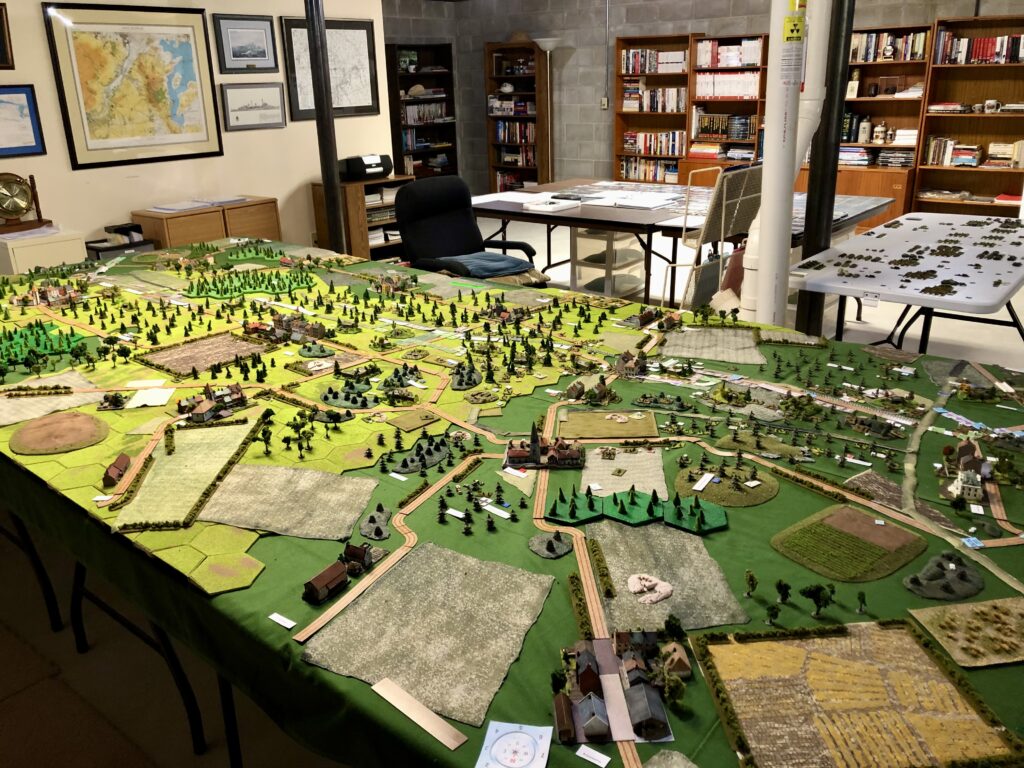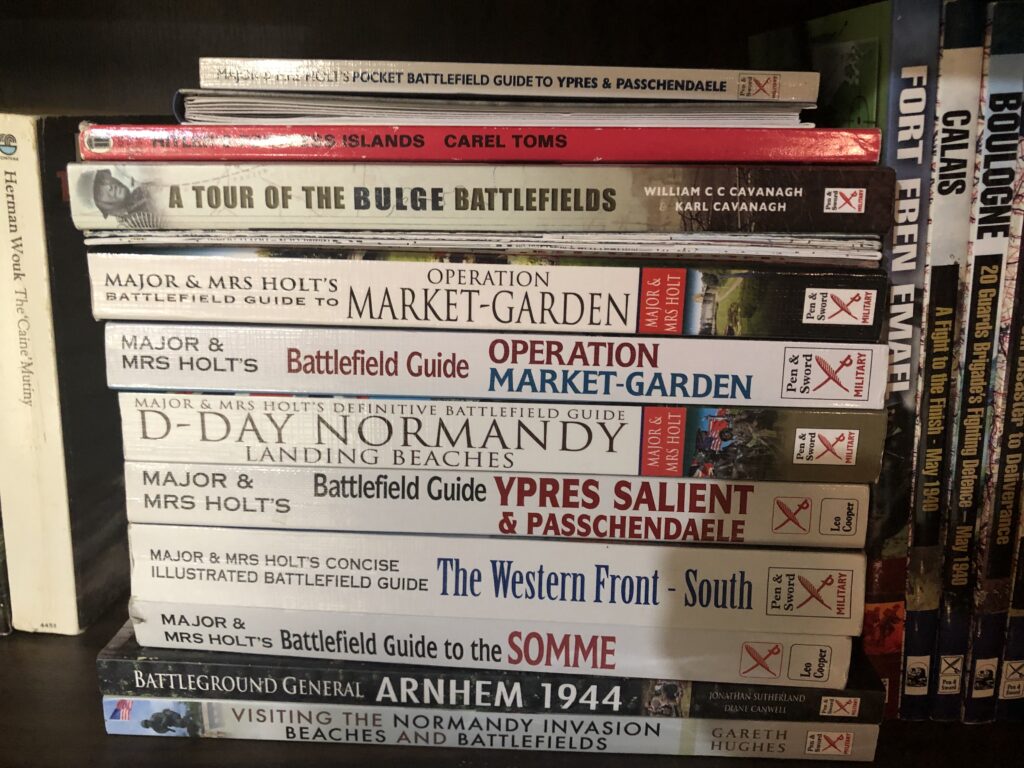This blog builds on the previous one by identifying additional essential references, beginning a discussion of considerations regarding miniature wargaming, and introducing helpful battlefield self-guided tour books.
Reading and Map Study
My first blog provided a review of the US Army official histories of the 1944-45 operations in the ETO, better known as the Green Books. I have been reading and referring to these volumes since I was in junior high!
A similar work covering the operations of the Canadian Army is Colonel C.P. Stacey’s The Victory Campaign — The Operations in North-West Europe, 1944-1945. Published in 1960 by the Minister of National Defense, this is Volume III in the Official History of the Canadian Army in the Second World War. Its coverage is as detailed as that of the Green Books. Its combination of foldout and single page maps are ideal for selecting playable operations. One difference from the US Army Green Books is that the maps in the Canadian volume do not show unit boundaries and zones. However, the appendices provide informative directives, an extensive order of battle, and a list of commanders and senior staff officers at the army, corps, division, and separate brigade levels, as well the Canadian Army Groups, Royal Artillery (AGRAs), the approximate counterpart to the US Army Field Artillery Groups.
The British counterpart to the Green Books and The Victory Campaign are the two volumes of Major L.F. Ellis’ Victory in the West published in 1962 and 1968 and republished by The Battery Press’ Official History Series in 1993 and 1994. Volume I — The Battle of Normandy and Volume II — The Defeat of Germany are part of the larger “Military Histories” series. The greatest difference between these volumes and their US and Canadian counterparts are their more extensive coverage of joint planning and operations and far less coverage at the division, regiment, and battalion levels. Detailed information comparable to that attainable in the US and Canadian volumes is best obtained from the large number of very detailed division, brigade, regiment, and battalion histories. Unfortunately, the maps in both volumes are inferior to those of US and Canadian works, being simple black and white with few details. However, the appendices provide the Directive to the Supreme Commander, Allied Expeditionary Force; a detailed naval order of battle and description of landing craft; a detailed order of battle for the British 21st Army Group; helpful notes on British Army organization, weapons, vehicles and other equipment; and similar information on the Allied tactical and strategic air forces. Both volumes also provide general information on the German army and air force.
A highly readable and influential work, primarily from the American perspective, is Russell Weigley’s Eisenhower’s Lieutenants — The Campaigns of France and Germany, 1944-45, published in 1981 by the Indiana University Press. I first read this book during a Mediterranean deployment onboard a destroyer. Given the pace of shipboard activity, I had little time to read it yet eagerly looked forward to each reading I could squeeze in. This is the book I would have loved to have written and it would have been a real pleasure to have met its author. If you are looking for a single, academic yet readable book about the 1944-45 campaign in the ETO, this is the one to read.
Another gem is John A. Adams’ The Battle for Western Europe, Fall 1944 — An Operational Assessment published in 2010, also by the Indiana University Press. It is, in my opinion, the most balanced study of the critical period following the breakout from Normandy and the ultimately futile effort to “end the war in ’44.” Adams’ focus is at the higher level of strategy, but it provides insight that makes for better informed battlefield visits and more realistic wargaming.

Miniature Wargaming — The Battlefield
Let’t take a look at the Battlefield in Miniature. For my study of corps and division level operations in the ETO, I wanted a battlefield large enough for battles between forces of division size. In the compartmented terrain typical of France, the Low Countries, and Germany, this also would provide for battles lasting the several or more days often required to achieve regimental and, in some cases, divisional objectives, as part of a corps level operation.
Size, scale, and proportion are interrelated concepts and all three should be taken into consideration when thinking about how to wargame in miniature.
Scale is the relative size of different objects in relation to each other or a common standard. I use model figures with a size of 1:235, the physical dimension of the models. At 1:235, the scale is 6mm. I wargame on a surface that is 12.5 by 6 feet. With one inch representing 100 yards, this provides for a battlefield of about 8.5 miles/13.7 kilometers by 4.1 miles/6.6 kilometers. This area is equivalent to most or all of a division’s zone of operations, typical troop densities, and battles lasting several days or as much as a week.
A larger size or smaller scale reduces the area of the battlefield, and drops the level of the command to below division. While this would still make for interesting battles to study, a much larger gaming table would be needed to cover division-sized battle. I am fortunate to have such a large gaming table that can be left undisturbed, but most gamers have less space and solitude for the hobby. Nonetheless, even with a smaller battlefield, students of the 1944/45 operations can use miniature wargaming to acquire a better understanding of command, planning, and tactics than possible using most available rules sets.
I accept that any division sized operation involving extended large scale maneuver — such as Operation Cobra or the pursuit across France — will be a short game lasting at most a day. In such a situation, I design successive games that require resetting the battlefield for a series of engagements forming a campaign.

Battlefield Visits
A good guidebook can make all the difference.
In 1991 during a visit to London’s Imperial War Museum (IWM), I first came upon two series of battlefield guides literally days before Margot and I crossed the Channel to Normandy in 1991. Prior to our arrival in the UK, I was oblivious to the existence of such references. I purchased an armful at the IWM that made all the difference in maximizing the one week we had for our first visit. (By the way, the IWM is one of the essential military museums to visit in Europe.)
This was our first encounter with Major Tonie and Mrs. Valmai Holt (aka Major and Mrs. Holt) and their series of guidebooks to the battlefields of the First and Second World Wars. They have authored the definitive guides for first time and return visitor to Normandy and the Operation Market-Garden battlefields. We have also used their guidebooks to the Great War battlefields in France. Each volume, updated every few years, provides everything needed for visiting the important sites on the battlefields. In addition to providing good historical overviews, each of these superb volumes includes well-designed, easy to follow tour routes with estimated time needed to see everything. Pen & Sword Publisher in the UK also developed the “Battleground Europe” series of similar tour books that are less impressive in appearance, but still very useful. I have a huge collection of these from both World Wars and highly recommend them to battlefield visitors.
Beginning in 2001, Sutton Publishing, also in the UK, developed the “Battle Zone Normandy” series of fourteen volumes. Each hardcover volume is under 200 pages and provides sections on the history of the battlefield and a series of tours similar to those of the previously mentioned guidebooks.
One additional reference that has greatly assisted my battlefield visits over the years is the magazine “After the Battle.” This incredibly informative quarterly magazine publishes extensively-researched articles accompanied by “then” and “now” photos, useful maps, and directions to the sites covered. “After the Battle” continues to publish new editions and every issue remains available from RZM Publications. I have found that even issues going back many years — decades in fact — remain useful in planning battlefield visits.
Unfortunately, what seemed to be a thriving era of battlefield guidebook publication seemed to slow down even before covid. The number of new and updated volumes is very limited. Perhaps I have missed recent publications and, if you know of any, particularly for the Ardennes and Alsace, I’d be interested in learning of them.
I will refer to these and other battlefield guidebooks in future posts covering specific battlefields.
I welcome your short comments below. To begin a discussion among viewers, place click on Forms at the top or bottom of the page.